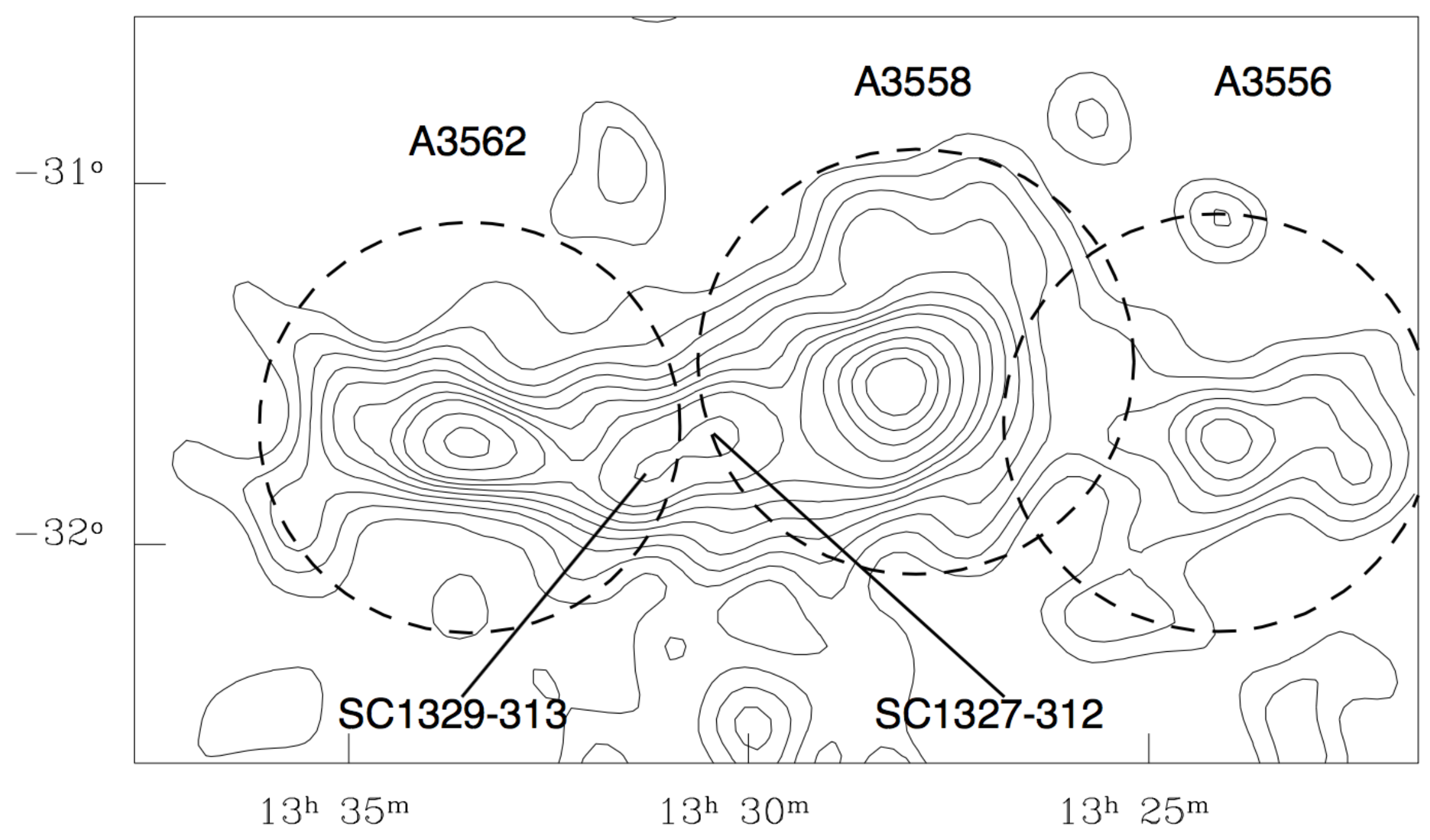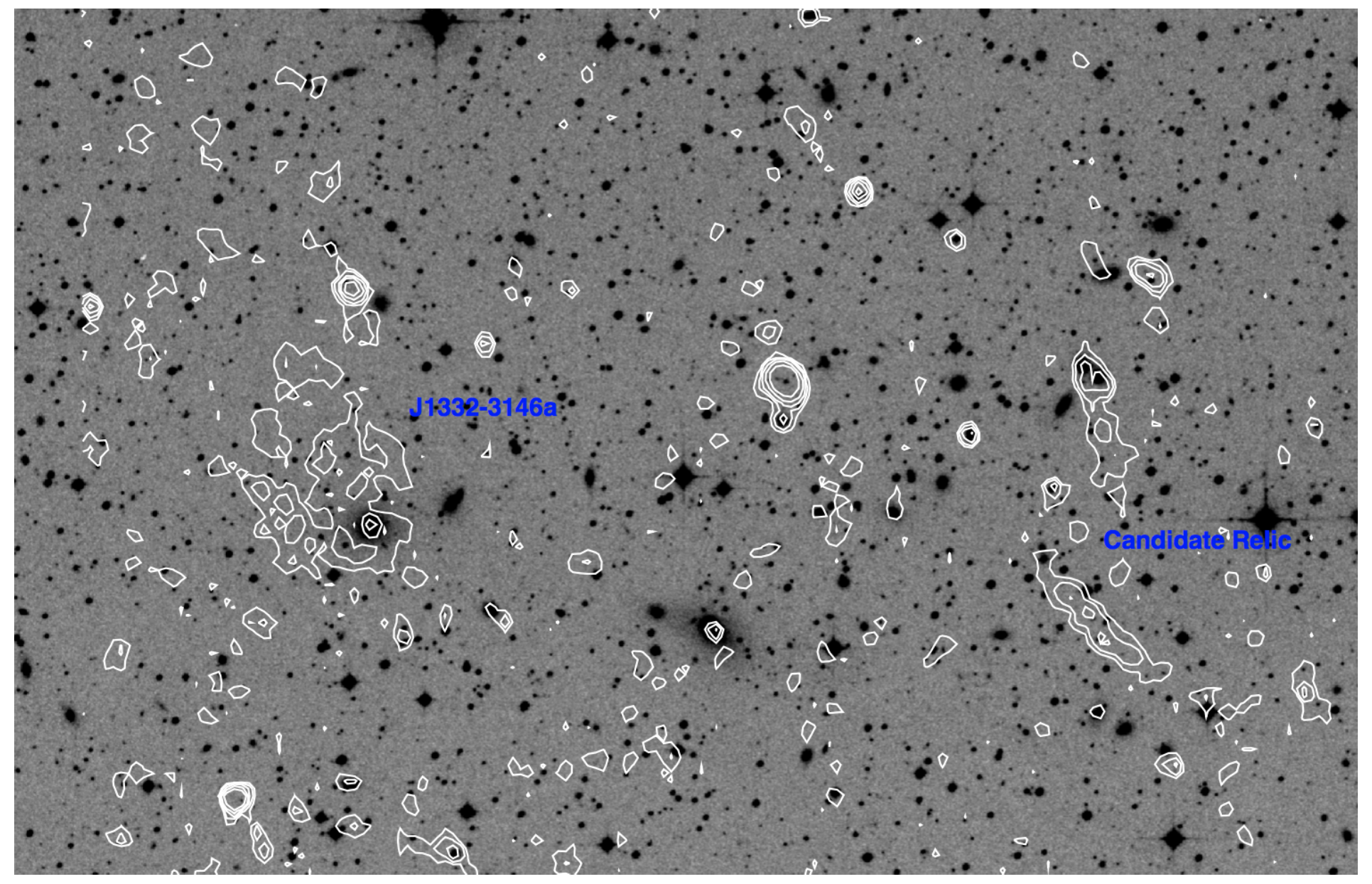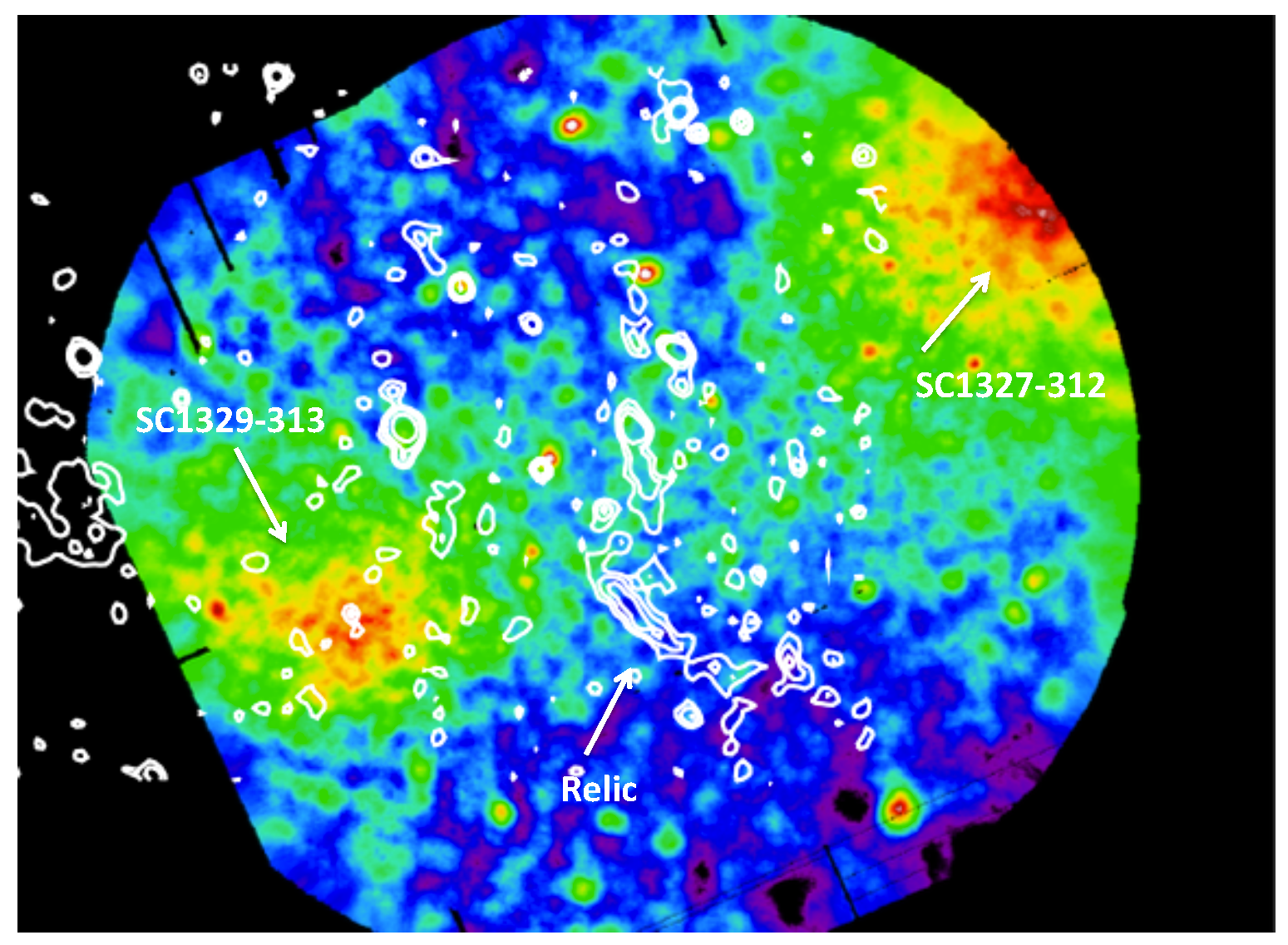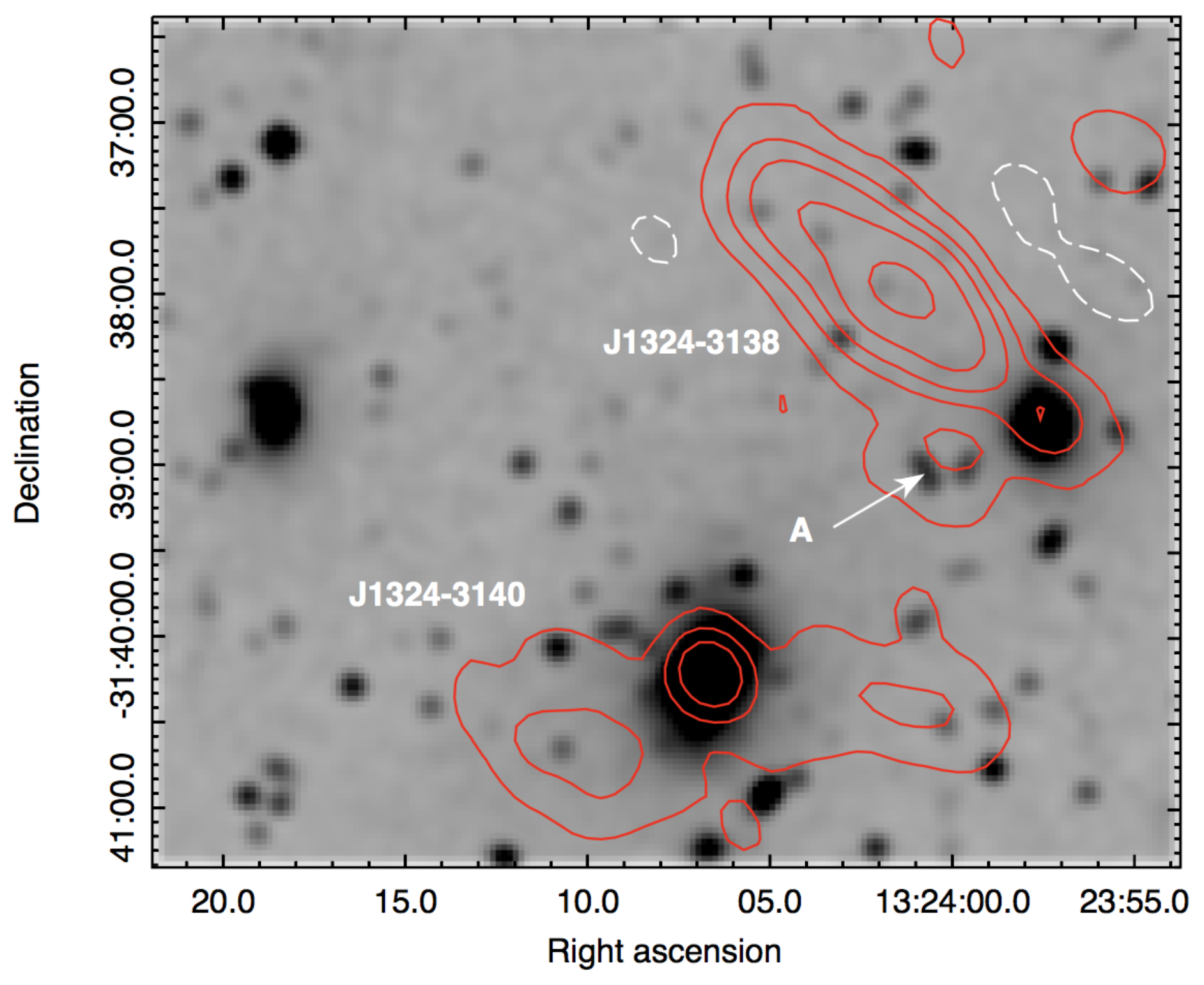Extended Radio Emission in the Perhipheral Regions of the Shapley Concentration Core
Abstract
:1. Cluster Mergers and Diffuse Radio Emission
- (1)
- (2)
- (3)
- the occurrence of radio halos is a steep function of the cluster mass; i.e., the number of radio halos increases considerably for masses M M (Cuciti et al. [7] and references therein), a result which is consistent with the expectations of the turbulent re-acceleration model;
- (4)
- giant radio halos with ultrasteep spectrum ( for S) have been found by means of deep observations at frequencies below 1 GHz (some remarkable examples are A 521, Brunetti et al. [8] and Dallacasa et al. [9]; A 697, Macario et al. [10]; RXCJ 1514.9-1523, Giacintucci et al. [11]). Such class of diffuse cluster sources is predicted by the re-acceleration model in the presence of minor mergers; i.e., less energetic and/or less massive ( M) merger events (Cassano [12]);
- (5)
- the connection between radio relics and cluster mergers is also well established (e.g., Ensslin et al. [13]; Hoeft & Brüggen [14]). They are found in the outskirts of galaxy clusters, and are thought to trace shock waves generated during merger events. The details of the re-acceleration in relics is still debated, and a clear association between relics and shocks has only been seen in few cases. As a matter of fact, the detection of shocks in galaxy clusters is challenging, partly because projection effects could hide temperature and density jumps, and partly because the strongest shocks are expected in the clusters outskirts, where the X-ray brightness is low. Remarkable examples of relics at merger shocks are A 754 (Macario et al. [15]), A 115 (Botteon et al. [16]), and CIZA J 2242.8+5301 (Ogrean et al. [17]). As for radio halos, scaling relations seem to hold for relics, too, though with high dispersion (de Gasperin et al. [18]).
2. The Shapley Concentration in Context
- (1)
- (2)
- A 3558 itself is an intriguing cluster. On the basis of a deep analysis based on XMM–Newton and Chandra data, Rossetti et al. [31] classified it as an intermediate case between cool-core and non-cool-core cluster: a cold front is located at ∼100 kpc in the SE direction, and more recently, two new candidate cold fronts at ∼500 kpc and at ∼1 Mpc, respectively SE and NW of the cluster centre, have been found (Rossetti et al., in prep.). Rossetti et al. [31] concluded that the relaxation process of A 3558 has most likely been perturbed either by the passage of the small group SC 1327–312 or by an off-axis merger with a more massive cluster, whose debris are A 3562 and the two SC groups in the region between A 3558 and A 3562 (see Figure 1);
- (3)
- the clusters in the A 3528 complex are most likely in a pre-merger stage, as suggested by the X-ray properties (Gastaldello et al. [30]) and by the properties of the radio galaxies (Lakhchaura et al. [44], Di Gennaro et al. [45]): the radio emission from the BCGs (Brightest Cluster Galaxies) in A 3528 and A 3532 is typical of very relaxed systems; i.e., high radio power and extended morphology with tails and signs of restarted activity.
3. Observations
4. Results
4.1. The Relic
4.2. Restarted Radio Emission in J 1332–3146a?
4.3. The Western End of the A 3558 Complex: A 3556
5. Conclusions
Acknowledgments
Author Contributions
Conflicts of Interest
References
- Feretti, L.; Giovannini, G.; Govoni, F.; Murgia, M. Clusters of galaxies: Observational properties of the diffuse radio emission. Astron. Astrophys. Rev. 2012, 20, 54. [Google Scholar] [CrossRef]
- Brunetti, G.; Jones, T.W. Cosmic Rays in Galaxy Clusters and Their Nonthermal Emission. Int. J. Mod. Phys. 2014, 23, 1430007. [Google Scholar] [CrossRef]
- Kale, R.; Venturi, T.; Giacintucci, S.; Dallacasa, D.; Cassano, R.; Brunetti, G.; Cuciti, V.; Macario, G.; Athreya, R. The Extended GMRT Radio Halo Survey. II. Further results and analysis of the full sample. Astron. Astrophys. 2015, 579, A92. [Google Scholar] [CrossRef]
- Cassano, R.; Ettori, S.; Brunetti, G.; Giacintucci, S.; Pratt, G.W.; Venturi, T.; Kale, R.; Dolag, K.; Markevitch, M. Revisiting the Scaing Relations for Giant Radio Halos in Galaxy Clusters. Astrophys. J. 2013, 777, 141. [Google Scholar] [CrossRef]
- Buote, D.A. On the Origin of Radio Halos in Galaxy Clusters. Astrophys. J. Lett. 2001, 553, L15. [Google Scholar] [CrossRef]
- Cassano, R.; Ettori, S.; Giacintucci, S.; Brunetti, G.; Markevitch, M.; Venturi1, T.; Gitti, M. On the Connection Between Giant Radio Halos and Cluster Mergers. Astrophys. J. Lett. 2010, 721, L82. [Google Scholar] [CrossRef]
- Cuciti, V.; Cassano, R.; Brunetti, G.; Dallacasa, D.; Kale, R.; Ettori, S.; Venturi, T. Occurrence of radio halos in galaxy clusters. Insight from a mass-selected sample. Astron. Astrophys. 2015, 580, A97. [Google Scholar] [CrossRef]
- Brunetti, G.; Giacintucci, S.; Cassano, R.; Lane, W.; Dallacasa, D.; Venturi, T.; Kassim, N.E.; Setti, G.; Cotton, W.D.; Markevitch, M. A low-frequency radio halo associated with a cluster of galaxies. Nature 2008, 455, 944–947. [Google Scholar] [CrossRef]
- Dallacasa, D.; Brunetti, G.; Giacintucci, S.; Cassano, R.; Venturi, T.; Macario, G.; Kassim, N.E.; Lane, W.; Setti, G. Deep 1.4 GHz Follow-up of the Steep Spectrim Radio Halo in A521. Astrophys. J. 2009, 699, 1288. [Google Scholar] [CrossRef]
- Macario, G.; Venturi, T.; Brunetti, G.; Dallacasa, D.; Giacintucci, S.; Cassano, R.; Bardelli, S.; Athreya, R. The very steep spectrum radio halo in Abell 697. Astron. Astrophys. 2010, 517, A43. [Google Scholar] [CrossRef]
- Giacintucci, S.; Dallacasa, D.; Venturi, T.; Brunetti, G.; Cassano, R.; Markevitch, M.; Athreya, R.M. An unlikely radio halo in the low X-ray lumoinous galaxy cluster RXC J1514.9-1523. Astron. Astrophys. 2011, 534, A57. [Google Scholar] [CrossRef]
- Cassano, R. Radio halos, cluster mergers and the role of future LOFAR observations. Mem. Soc. Astron. Ital. 2011, 82, 531. [Google Scholar]
- Ensslin, T.A.; Biermann, P.L.; Klein, U.; Kohle, S. Cluster radio relics as a tracer of shock waves of the large-scale structure formation. Astron. Astrophys. 1998, 332, 395. [Google Scholar]
- Hoeft, M.; Brüggen, M. Radio signature of cosmological structure formation shocks. Mon. Not. R. Astron. Soc. 2007, 375, 77–91. [Google Scholar] [CrossRef]
- Macario, G.; Markevitch, M.; Giacintucci1, S.; Brunetti, G.; Venturi, T.; Murray, S.S. A Shock Front in the Merging Galaxy Cluster A754: X-ray and Radio Observations. Astrophys. J. 2011, 728, 82. [Google Scholar] [CrossRef]
- Botteon, A.; Gastaldello, F.; Brunetti, G.; Dallacasa, D. A shock at the radio relic position in Abell 115. Mon. Not. R. Astron. Soc. Lett. 2016, 460, L84–L88. [Google Scholar] [CrossRef]
- Ogrean, G.A.; Brüggen, M.; van Weeren, R.; Röttgering, H.; Simionescu, A.; Hoeft, M.; Croston, J.H. Multiple density discontinuities in the merging galaxy cluster CIZA J2242.8+5301. Mon. Not. R. Astron. Soc. 2014, 440, 3416–3425. [Google Scholar] [CrossRef]
- De Gasperin, F.; van Weeren, R.J.; Brüggen, M.; Vazza, F.; Bonafede, A.; Intema, H.T. A new double radio relic in PSZ1 G096.89+24.17 and a radio relic mass-luminosity relation. Mon. Not. R. Astron. Soc. 2014, 444, 3130–3138. [Google Scholar] [CrossRef]
- Bonafede, A.; Intema, H.T.; Brüggen, M.; Russell, H.R.; Ogrean, G.; Basu, K.; Sommer, M.; van Weeren, R.J.; Cassano, R.; Fabian, A.C.; et al. A giant radio halo in the cool core cluster CL 1821+643. Mon. Not. R. Astron. Soc. Lett. 2014, 444, L44–L48. [Google Scholar] [CrossRef]
- Kale, R.; Parekh, V. How unusual is the cool-core radio halo cluster CL 1821+643? Mon. Not. R. Astron. Soc. 2016, 459, 2940–2947. [Google Scholar] [CrossRef]
- Farsnworth, D.; Rudnick, L.; Brown, S.; Brunetti, G. Discovery of Megaparsec-scale, Low Surface Brigthness Nonthermal Emission in Merging Galaxy Clusters Using the Green Bank Telescope. Astrophys. J. 2013, 779, 189. [Google Scholar]
- Venturi, T.; Rossetti, M.; Brunetti, G.; Farnsworth, D.; Gastaldello, G.; Giacintucci, S.; Lal, D.V.; Rudnick, L.; Shimwell, T.W.; Eckert, D.; et al. The two-component giant radio halo in the galaxy cluster A 2142. Astron. Astrophys. 2017. submitted. [Google Scholar]
- Sommer, M.W.; Basu, K.; Intema, H.; Pacaud, F.; Bonafede, A.; Babul, A.; Bertoldi, F. Mpc-scale diffuse radio emission in two massive cool-core clusters of galaxies. Mon. Not. R. Astron. Soc. 2017, 466, 996. [Google Scholar] [CrossRef]
- Cassano, R.; Brunetti, G.; Norris, R.P.; Röttgering, H.J.A.; Johnston-Hollitt, M.; Trasatti, M. Radio halos in future surveys in the radio continuum. Astron. Astrophys. 2012, 584, A100. [Google Scholar] [CrossRef]
- Cassano, R.; Bernardi, G.; Brunetti, G.; Brüggen, M.; Clarke, T.; Dallacasa, D.; Dolag, K.; Ettori, S.; Giacintucci, S.; Giocoli, C.; et al. Cluster radio halos at the crossroad between astrophysics and cosmology in the SKA era. In Proceedings of the Advancing Astrophysics with the SKA (AASKA14), Giardini Naxos, Italy, 9–13 June 2014; p. 73.
- Gitti, M.; Tozzi, P.; Brunetti, G.; Cassano, R.; Dallacasa, D.; Edge, A.; Ettori, S.; Feretti, L.; Ferrari, C.; Giacintucci, S. The SKA view of cool-core clusters: Evolution of radio mini-halos and AGN feedback. In Proceedings of the Advancing Astrophysics with the SKA (AASKA14), Giardini Naxos, Italy, 9–13 June 2014; p. 76.
- Reisenegger, A.; Quintana1, H.; Carrasco, E.R.; Maze, J. The Shapey Supercluster. III. Collapse Dynamics and Mass of the Central Concentration. Astrophys. J. 2000, 120, 523. [Google Scholar]
- De Filippis, E.; Schindler, S.; Erben, T. The Shapley super-cluster. New X-ray detections and mass distribution. Astron. Astrophys. 2005, 444, 387–402. [Google Scholar] [CrossRef]
- Ettori, S.; Fabian, A.C.; White, D.A. On the mass distribution of the Shapley Supercluster inferred from X-ray observations. Mon. Not. R. Astron. Soc. 1997, 289, 787–800. [Google Scholar] [CrossRef]
- Gastaldello, S.; Ettori, S.; Molendi, S.; Bardelli, S.; Venturi, T.; Zucca, E. XMM-Newton observations of the interacting cluster Abell 3528. Astron. Astrophys. 2003, 411, 21–32. [Google Scholar] [CrossRef]
- Rossetti, M.; Ghizzardi, S.; Molendi, S.; Finoguenov, A. A cluster in a crowded environment: XMM-Newton and Chandra observations of A 3558. Astron. Astrophys. 2007, 463, 839–851. [Google Scholar] [CrossRef]
- Ursino, E.; Galeazzi, M.; Gupta, A.; Kelley, R.L.; Mitsuishi, I.; Ohashi, T.; Sato, K. Exploring the Bridge between A 3556 and A 3558 in the Shapley Supercluster. Astrophys. J. 2015, 806, 211. [Google Scholar] [CrossRef]
- Venturi, T.; Bardelli, S.; Morganti, R.; Hunstead, R.W. Radio properties of the Shapley Concentration—I. The Abell cluster A 3556. Mon. Not. R. Astron. Soc. 1997, 285, 898–912. [Google Scholar] [CrossRef]
- Venturi, T.; Bardelli, S.; Morganti, R.; Hunstead, R.W. Radio properties of the Shapley Concentration—III. Merging clusters in the A 3558 complex. Mon. Not. R. Astron. Soc. 2000, 314, 594–610. [Google Scholar] [CrossRef]
- Venturi, T.; Bardelli, S.; Zambelli, G.; Morganti, R.; Hunstead, R.W. Radio properties of the Shapley Concentration—IV. The A 3528 cluster complex. Mon. Not. R. Aston. Soc. 2001, 324, 1131–1146. [Google Scholar] [CrossRef]
- Venturi, T.; Rossetti, M.; Bardelli, S.; Giacintucci, S.; Dallacasa, D.; Cornacchia, M.; Kantharia, N.G. Radio emission at the centre of the galaxy cluster Abell 3560: Evidence for core sloshing? Astron. Astrophys. 2013, 558, A146. [Google Scholar] [CrossRef]
- Giacintucci, S.; Venturi, T.; Bardelli, S.; Dallacasa, D.; Zucca, E. AGN and starburst radio activity in the A 3558 cluster complex. Astron. Astrophys. 2004, 419, 71–87. [Google Scholar] [CrossRef]
- Giacintucci, S.; Venturi, T.; Brunetti, G.; Bardelli, S.; Dallacasa, D.; Ettori, S.; Finoguenov, A.; Rao, A.P.; Zucca, E. Spectral properties and origin of the radio halo in A 3562. Astron. Astrophys. 2005, 440, 867–879. [Google Scholar] [CrossRef]
- Haines, C.P.; Busarello, G.; Merluzzi, P.; Smith, R.J.; Raychaudhury, S.; Mercurio, A.; Smith, G.P. ACCESS—II. A complete census of star formation in the Shapley supercluster. UV and IR luminosity functions. Mon. Not. R. Aston. Soc. 2011, 412, 127–144. [Google Scholar] [CrossRef]
- Merluzzi, P.; Busarello, G.; Dopita, M.A.; Haines, C.P.; Steinhauser, D.; Mercurio, A.; Rifatto, A.; Smith, R.J.; Schindler, S. ACCESS—V. Dissecting ram-pressure stripping through integral field spectroscopy and multiband imaging. Mon. Not. R. Aston. Soc. 2013, 429, 1747–1773. [Google Scholar] [CrossRef]
- Merluzzi, P.; Busarello, G.; Haines, C.P.; Mercurio, A.; Okabe, N.; Pimbblet, K.J.; Dopita, M.A.; Grado, A.; Limatola, L.; Bourdin, H.; et al. Shapley Supercluster Survey: Galaxy evolution from filaments to cluster cores. Mon. Not. R. Aston. Soc. 2015, 446, 803–822. [Google Scholar] [CrossRef]
- Venturi, T.; Bardelli, S.; Dallacasa, D.; Brunetti, G.; Giacintucci, S.; Hunstead, R.W.; Morganti, R. The radio halo in the merging cluster A 3562. Aston. Astrophys. 2003, 402, 913–920. [Google Scholar] [CrossRef]
- Merluzzi, P.; Busarello, G.; Dopita, M.A.; Haines, C.P.; Steinhauser, D.; Bourdin, H.; Mazzotta, P. Shapley Supercluster Survey: Ram-pressure stripping versus tidal interactions in the Shapley supercluster. Mon. Not. R. Aston. Soc. 2016, 460, 3345–3369. [Google Scholar] [CrossRef]
- Lakhchaura, K.; Singh, K.P.; Saikia, D.J.; Hunstead, R.W. A Cluster Pair: A 3532 and A 3530. ApJ 2013, 767, 91. [Google Scholar] [CrossRef]
- Di Gennaro, G.; Venturi, T.; Dallacasa, D.; Giacintucci, S. Cosmic Dance in the Shapley Concentration Core: radio emission from the BCGs and tailed radio galaxies. A&A 2017, in press. [Google Scholar]
- Prasad, J.; Chengalur, J. FLAGCAL: A flagging and calibration package for radio interferometric data. Exp. Astron. 2012, 33, 157–171. [Google Scholar] [CrossRef]
- Bardelli, S.; De Grandi, S.; Ettori, S.; Molendi, S.; Zucca, E.; Colafrancesco, S. SC 1327-–312 & SC 1329-–313: Two galaxy groups in-between a major merging event observed with Beppo—SAX. Astron. Astrophys. 2002, 382, 17. [Google Scholar]
- Intema, H.; Jagannathan, P.; Mooley, K.P.; Frail, D.A. The GMRT 150 MHz All-sky Radio Survey: First Alternative Data Release TGSS ADR1. Astron. Astrophys. 2017, 598, A78. [Google Scholar] [CrossRef]
- Venturi, T.; Venturi, T.; Bardelli, S.; Morganti, R.; Hunstead, R.W. Radio properties of the Shapley Concentration—II. J1324-3138: A remnant of a radio galaxy in the Abell cluster A3556? Mon. Not. R. Astron. Soc. 1998, 298, 1113–1122. [Google Scholar] [CrossRef]





© 2017 by the authors. Licensee MDPI, Basel, Switzerland. This article is an open access article distributed under the terms and conditions of the Creative Commons Attribution (CC BY) license ( http://creativecommons.org/licenses/by/4.0/).
Share and Cite
Venturi, T.; Bardelli, S.; Dallacasa, D.; Di Gennaro, G.; Gastaldello, F.; Giacintucci, S.; Rossetti, M. Extended Radio Emission in the Perhipheral Regions of the Shapley Concentration Core. Galaxies 2017, 5, 16. https://doi.org/10.3390/galaxies5010016
Venturi T, Bardelli S, Dallacasa D, Di Gennaro G, Gastaldello F, Giacintucci S, Rossetti M. Extended Radio Emission in the Perhipheral Regions of the Shapley Concentration Core. Galaxies. 2017; 5(1):16. https://doi.org/10.3390/galaxies5010016
Chicago/Turabian StyleVenturi, Tiziana, Sandro Bardelli, Daniele Dallacasa, Gabriella Di Gennaro, Fabio Gastaldello, Simona Giacintucci, and Mariachiara Rossetti. 2017. "Extended Radio Emission in the Perhipheral Regions of the Shapley Concentration Core" Galaxies 5, no. 1: 16. https://doi.org/10.3390/galaxies5010016





